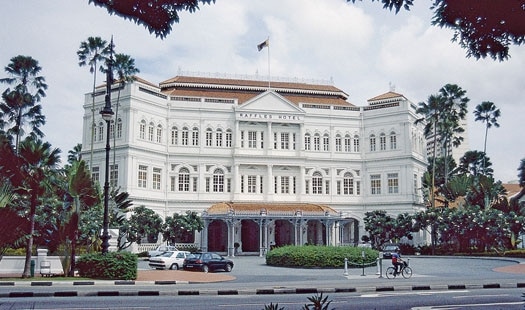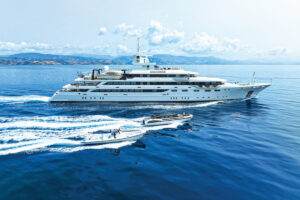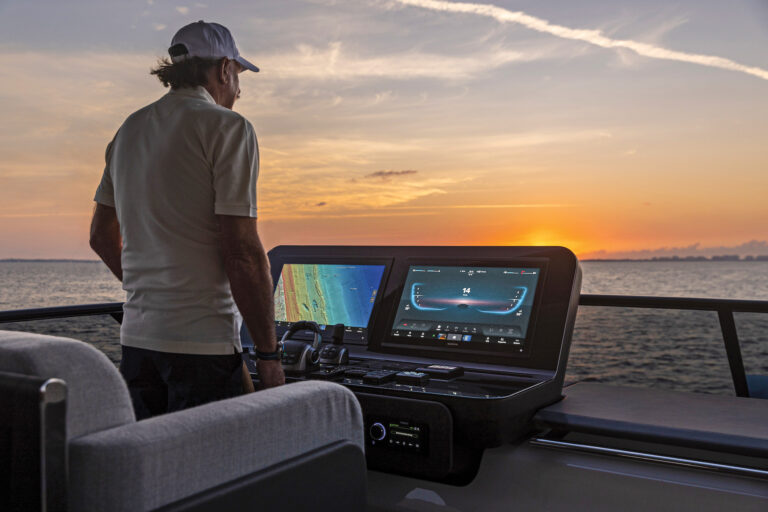
The famous Raffles Hotel in Singapore. Bring your checkbook.
The drive from the Bangkok airport is all it takes to make you realize why there’s so much traffic on the Chao Phraya. On the highway progress is painfully slow-you can almost measure it in yards per hour-whereas on the adjacent river the passenger traffic zooms along at 30 knots or more. Water is the way to travel in Thailand.
The river was also to be our route to the sea on the first modern luxury motoryacht to be built in Thailand. The plan was simple: We were to deliver the prototype Ladenstein 2000 from Bangkok to Singapore where it was going on display at the Singapore Boat Show. Unlike many other cities that have turned their backs on their rivers, Bangkok uses its river as a major highway, with a unique range of boats providing transport for tourists, commuters and cargo. Navigating down the Chao Phraya opened up a new window on a world of cruising that few experience.
Everything about this trip was a bit surreal, starting with the boatbuilding yard, located in the Singha Brewery, the largest brewery in Thailand. Breweries and boatyards do not seem to have much in common, but the connection here is money and diversification. Thailand offers high-class workmanship in quality materials of low cost, so when Austrian builder Ladenstein was looking for a more economical way to build its quality motoryachts, Bangkok seemed a good place and a joint venture was set up. Certainly it had its advantages over, say, Poland, where many European boat companies are currently outsourcing construction in order to control costs. Our initial destination from the airport was the riverfront boatyard north of Bangkok, where the Ladenstein 2000 was built. From here we were to head south to Singapore with some diversions on the way to see the spectacular scenery and coastal life of Thailand and Malaysia.
You would normally have to drag me past a brewery, but here I was eager to see the yacht that was to be home for the next few days. It lay at the jetty on the fast flowing muddy river, a strong contrast to its surroundings. The 2000 is long, low and sleek; it looked lower than normal because we could not put the arch mast up until we had cleared the first low bridge across the river. Inside it was opulent with woods and fabrics. I was more than pleasantly surprised-the Ladenstein stands close scrutiny with the best from Europe and designer Markus Ladenstein has found a happy synthesis of international styling. Customers seem to be responding, too: The yard has already gone on to build larger versions and supply a limited production to selected clients, mainly in Europe.
Stocking up with drink was easy in the brewery, but food was more difficult to come by. Then it was off into the busy river, where we could erect the mast and antenna. The traffic became even more congested as we approached the center of Bangkok. Here, the contrasts were dramatic. Stately, slow ferries cross every half-mile or so, while high-speed commuter boats whisk passengers up and down the river, weaving around the plodding barge traffic. It all makes for a fever of excitement, particularly when you add in Thailand’s unique long-tail boats that act as water taxis.
A remarkable example of boat evolution, these long-tails were developed from the long, thin-hulled river boats originally designed for easy rowing. They were mechanized by simply mounting a large truck engine and gearbox on a swivel bracket at the stern. The prop shaft is a long tube extending out from the transom and up to 10 feet astern where the small two- or three-bladed propeller works like an egg whisk.
The driver sits in front of the engine, where another long tube acts as the tiller, with throttle and gear controls mounted on it. The swivel bracket provides the steering and the engine drive can be tilted, taking the propeller into surface-piercing mode at high speed. The driver perches precariously on two boxes as he drives the boat with demon-like skill at 40 knots. The engines drip oil, string is an essential repair material, and the exhausts have no silencers. Progress is wild and rapid, the exhaust roaring and belching black smoke while the rooster tail from the propeller indicates that the surface-piercing propeller was invented long before the West thought of the idea. Our Ladenstein looked positively slow alongside these boats.
Though the long-tail boats kept out of our way, the commuter ferries that ply regular routes up and down the river presented more of a challenge to our progress down river. Running at over 30 knots, they seem to employ a breed of driver trained in serious aggression. Speed is king on the Chao Phraya and the faster you go, it seems, the higher priority you have. So the slow ferries thread a tentative course, weaving between the faster traffic that uses its strident horns to demand right of way.
Certainly, there are no speed limits. Twice a day Thailand’s Coast Guard patrol boat cruises up and down the river at a leisurely pace, but it is a token gesture. There are no rules of the road; it is survival of the fittest, and it works. The commuter ferries with their graceful swan-neck bows fight for space at the landing stages. The long-tail boats know their place and sneak in when there is a gap, and somehow the cross-river ferries find a space too. Passengers have to be quick, since the boats are alongside for 20 seconds or so, hence the marshals with portable loud hailers who harangue the crowds to jump quickly. Organized chaos, indeed.
The heavy traffic did not give us a lot of time to look at the scenery, a pity as it can be quite spectacular. Gold-plated temple domes contrast with the high-rise modern offices. Yet it was quite a relief to pass the last of the bridges and the downriver shipping terminals and head out to sea.
I don’t think I have ever started a cruise with such a range of contrasting landscapes. But now we had perfect cruising weather and we settled down to a 25-knot speed, the twin 1,200 hp MAN diesels murmuring with a quiet hum for the overnight run to the island of Koh Samui, almost due south. In the morning, in contrast to Bangkok, Koh Samui seemed from another world. Everything was peaceful with none of the hustle and bustle that characterizes Bangkok. This is take-your-time country, and we did just that as we stopped at the pier at Hat Bo Phut to pick up another crewmember, who had flown in. The airport terminal has a thatched roof and open sides with the jungle encroaching. Our main reason for coming here, however, was to visit the nearby Ang Thong National Marine Park. This is a spectacular group of islands combining high undercut limestone cliffs with brilliant white beaches, a true tropical paradise now being opened up to tourism.
After cruising the islands it was time to head south again, to our first refueling stop at Songkhla. As we had stayed in Ang Thong longer than planned it was dark when we arrived off Songkhla. Here is where we encountered our first and nearly last problem. The chart showed the entrance channel lined by lighted buoys, but none of the lights we could see seemed to conform to what was on the chart. There were tiny islands on each side of the entrance, which we should have picked out on the radar, but they were lost among the ships at anchor. Since breakwaters protect the river entrance and as the chart showed plenty of water for us, we decided to head in. We expected to pick up the open entrance between the breakwaters on the radar.
I was below watching the radar while the rest of the crew was up on the flybridge. As we approached the land, I could see what looked like the opening between the breakwaters. The opening looked clear and inviting as we closed it, and while still focused on the radar I was suddenly aware of shouting and the engines going full astern and the yacht coming to a rapid halt. Fifty yards in front of us was a very solid looking breakwater!
I could not understand this as the gap was still showing on the radar and then it dawned on me: The radar antenna was set very low on the arch mast and those three crew standing on the flybridge had been blocking the radar beam, creating what I thought was the gap. Once they sat down we followed the breakwater to find the real gap and entered the harbor. It was late and we were hungry, so I went off to stock up on food at the roadside stalls that sell all sorts of interesting looking, if not easily identifiable, comestibles.
Full of fuel and food we set off after midnight for the long run down the coast to the next stopping point, which would be in Malaysia. It was an amazing tropical night, with calm seas and stars shining right down to the horizon. The night was made more surreal when my cell phone rang and there I was, cruising under the moonlight in the South China Sea, doing a radio interview for the BBC in London. Modern life does get bizarre at times. We kept a little way off the coast to avoid the many small unlit fishing boats that operate around here. It was sad to miss some of the beautiful islands off the coast in the dark, but we had a deadline to meet and by dawn were well south.
Our next stop for fuel was Mersing, which is a small fishing port and the terminal for the ferries that run out to the many islands offshore. This is busy tourist country in the ministate of Jahor, but Mersing still retains much of the traditional fishing atmosphere with the tourist industry concentrating on the area around the beaches. Because our arrival coincided with a holiday, crowds of people were waiting for the island ferries to spend the day offshore.
The scene was just like Bangkok, albeit on a smaller scale, as we literally nudged our way into port. The trouble with a beautiful white yacht finish is that you cannot afford to touch anything, so we had to play it very defensively, squeezing our way into the refueling berth. Time for just a quick run ashore, and then we were off again and heading south to Singapore. Late afternoon saw us rounding the southeast corner of the Malay Peninsula and into some of the busiest shipping channels in the world.
What a contrast between the fishing port of Mersing and the busy commercial port of Singapore. It was like opening a door into another world where commerce rules. There were ships everywhere, many at anchor waiting for cargo, and small craft rushing between larger ships. Singapore seemed a lot more organized and controlled than Bangkok. We nudged our way into our allotted space in the marina inside Sentosa Island, close to the center of Singapore. We looked small alongside the superyachts, but the Ladenstein is a very comfortable size for cruising. This was the end of what had been a memorable trip in waters that are not familiar with yachts (a 75-foot fast motoryacht is something that most natives have never seen) but which will one day be as popular as the Mediterranean and Florida, if current economic and population trends hold to form. Thus, I was doubly glad to see it now, to cruise the enchanted islands and beaches. In a land where speed is king, who knows what will be left a decade from now?









